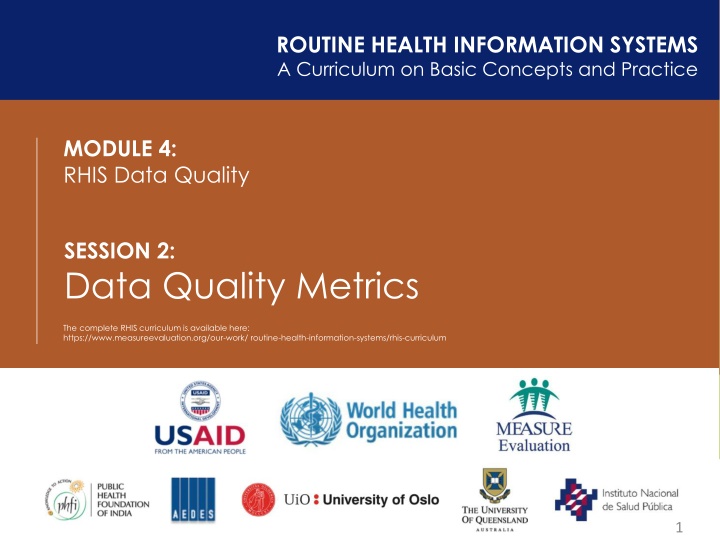
RHIS Data Quality Metrics and Analysis
"Explore data quality metrics in Routine Health Information Systems (RHIS), covering completeness, timeliness, internal consistency, external comparisons, and data triangulation. Learn how to evaluate data quality to enhance analysis and information use."
Download Presentation

Please find below an Image/Link to download the presentation.
The content on the website is provided AS IS for your information and personal use only. It may not be sold, licensed, or shared on other websites without obtaining consent from the author. If you encounter any issues during the download, it is possible that the publisher has removed the file from their server.
You are allowed to download the files provided on this website for personal or commercial use, subject to the condition that they are used lawfully. All files are the property of their respective owners.
The content on the website is provided AS IS for your information and personal use only. It may not be sold, licensed, or shared on other websites without obtaining consent from the author.
E N D
Presentation Transcript
ROUTINE HEALTH INFORMATION SYSTEMS A Curriculum on Basic Concepts and Practice MODULE 4: RHIS Data Quality SESSION 2: Data Quality Metrics The complete RHIS curriculum is available here: https://www.measureevaluation.org/our-work/ routine-health-information-systems/rhis-curriculum 1
Learning Objectives and Topics Covered Objectives Understand data quality dimensions and metrics Completeness and timeliness o Internal consistency o External consistency o External comparisons o Be able to calculate and interpret data quality metrics Understand data triangulation and how it can strengthen analysis and information use Topics Covered Data-quality metrics, with examples Measurement and analysis of data-quality metrics Data triangulation 2
Metrics for Data Quality Performance Completeness and timeliness o Completeness of reports o Completeness of data o Timeliness of reports Internal consistency o Accuracy o Outliers o Trends o Consistency between indicators External consistency o Data triangulation o Comparison with data surveys o Consistency of population trends External comparisons (population denominators) 3
Completeness and Timeliness of Data This examines the extent to which: Data reported through the system are available and adequate for the intended purpose All entities that are supposed to report are actually reporting Data elements in submitted reports are complete Reports are submitted/received on time through the levels of the information system data flow 4
Availability and Completeness of Data Availability of reports (%) = # total reports available or received # total reports expected Completeness of reports (%) = # reports that are complete (all data elements filled out) # total reports available or received 5
Completeness and Timeliness of Data Completeness of data (%) = # values entered (not missing) in the report # total data elements in the report Timeliness (%) = # reports submitted or received on time # total reports available or received 6
Internal Consistency of Reported Data This dimension examines: The accuracy of reporting of selected indicators, by reviewing source documents Whether data are free of outliers (within bounds), by assessing whether specific reported values within the selected period (such as monthly) are extreme, relative to the other values reported Trends in reporting over time, to identify extreme or implausible values year-to-year The program indicator compared to other indicators with which they have a predicable relationship, to determine whether the expected relationship exists between the two indicators 7
Accuracy: Data Verification Quantitative: Compares recounted to reported data In-depth verifications at the service delivery sites Assess on a limited scale if sites are collecting and reporting data accurately and on time Implement in 2 stages Follow-up verifications at the intermediate and central levels 8
Accuracy: Verification Factor Verification Factor Over-reporting: <100% Under-reporting: >100% Numerator: Recounted data Denominator: Reported data Suggested range of acceptability: 100% +/- 10% (90% 110%) 10
Verification Factor Example Data accuracy by district Indicators flagged in red are verification factors 10% of 1. Indicator 1 Indicator 2 v Recounted Reported VF Recounted Reported VF A 1212 1065 1.14 4009 4157 0.96 B 1486 1276 1.16 3518 3686 0.95 C 357 387 0.92 672 779 0.86 D 2987 3849 0.78 1361 1088 1.25 E 4356 4509 0.97 4254 3970 1.07 11
Verification Factors Plotted Graphically DT: Is this animated? See notes. underreported over-reported 12
Monitoring Data Quality Assessment Results over Time You can use a line graph to plot verification factors over time to show improvements or other changes. This can guide future planning and action. 13
Internal Consistency: Outliers Definition Metric Severity National Level Subnational Level Extreme # (%) of subnational units in which 1 of the monthly subnational unit values over the course of 1 year is an extreme outlier value % of monthly subnational unit values that are extreme outliers (At least 3 standard deviations from the mean) Outliers (Analyze each indicator separately.) Moderate # (%) of subnational units in which 2 of the monthly subnational unit values over the course of 1 year are moderate outliers % of subnational unit values that are moderate outliers (Between 2 3 standard deviations from the mean, or >3.5 on modified Z-score method) 14
Example: Outliers in a Given Year Months with at least one moderate outlier on the district monthly reports are shown in red. Month Total Outliers % Dist Outliers 1 2 3 4 5 6 7 8 9 10 11 12 A 2543 2482 2492 2574 3012 2709 3019 2750 3127 2841 2725 1 8.3% 2103 B 1184 1118 1195 1228 1324 1322 1160 1178 1084 1112 2 16.7% 1601 711 C 776 541 515 527 857 782 735 694 687 628 596 543 0 0% D 3114 2931 2956 4637 4340 3788 3939 3708 4035 3738 3606 1 8.3% 6288 E 1382 1379 1134 1378 1417 1302 1415 1169 1369 1184 1207 1079 0 0% Nat l 0 0 0 0 2 0 0 1 0 0 0 1 4 6.7% 15
Internal Consistency: Trends Over Time Definition Metric National Level Subnational Level Conduct one of the following, based on indicator s expected trend: # (%) of districts whose ratio of current year to predicted value (or current year to average of preceding 3 years) is at least 33% of national ratio Indicators or programs with expected growth: Trends/ Consistency over Time Compare current year to the value predicted from the trend in the 3 preceding years Indicators or programs expected to remain constant: Compare current year to the average of 3 preceding years (Analyze each indicator separately.) Graphic depiction of trend to determine plausibility based on programmatic knowledge 16
Example: Trends over Time Consistency trend: Comparison of district ratios to national ratios Any difference between district and national ratio that is 33% is highlighted in red. Mean of Preceding 3 Years (2010- 2012) Year Ratio of 2013 to Mean of 2010-2012 % Difference between National and District Ratios District 2010 2011 2012 2013 A 30242 29543 26848 32377 28878 1.12 0.03 B 19343 17322 16232 18819 17632 1.07 0.08 C 7512 7701 7403 7881 7539 1.05 0.09 15355 15047 14788 25123 15063 1.67 D 0.44 E 25998 23965 24023 24259 24662 0.98 0.16 17 National 98450 93578 89294 108459 93774 1.16
Internal Consistency: Comparing Related Indicators Definition Metric National Level Subnational Level # (%) of subnational units where there is an extreme difference ( 10%) Maternal Health: ANC1 - IPT1 or TT1 (should be roughly equal) # (%) of subnational units with # of DTP3 immunizations > DTP1 immunizations (negative dropout) Immunization: DTP3 dropout rate = (DTP1 - DTP3)/DTP1 (should not be negative) Consistency among related indicators # (%) of subnational units where there is an extreme difference ( 10%) HIV/AIDS: ART coverage - HIV coverage (should be <1) TB: TB cases notified - TB cases on treatment (should be roughly equal) # (%) of subnational units where there is an extreme difference ( 10%) Malaria: # confirmed malaria cases reported - cases testing positive (should be roughly equal) # (%) of subnational units where there is an extreme difference ( 10%) 18
Example: Internal Consistency % difference between ANC1 and IPT1, by district Districts with % difference 10% are flagged in red. Ratio of ANC1 to IPT1 % Difference between National & District Ratios District ANC1 IPT1 A 20995 18080 1.16 0.02 B 18923 16422 1.15 0.02 C 7682 6978 1.10 0.07 D 12663 9577 1.32 0.12 E 18214 15491 1.18 0 National 78477 66548 1.18 19
External Consistency with Other Data Sources This dimension examines the level of agreement between two sources of data measuring the same health indicator. The two sources of data are: The routinely collected and reported data from the health management information system (HMIS) or program-specific information system A periodic population-based survey 20
External Consistency: Compare with Survey Results Definition Examples of Indicators National Level Subnational Level Ratio of facility ANC1 coverage rates to survey ANC1 coverage rates # (%) of aggregation units used for the most recent population-based survey, such as province/state/region, whose ANC1 facility-based coverage rates and survey coverage rates differ by at least 33% ANC 1st visit Ratio of DTP3 coverage rates from routine data to survey DTP3 coverage rates # (%) of aggregation units used for the most recent population-based survey, such as province/state/region, whose DTP3 facility-based coverage rates and survey coverage rates differ by at least 33% 3rd dose DTP3 vaccine 21
Example: External Consistency Comparison of HMIS and survey coverage rates for ANC1 Differences 33% are highlighted in red. % Difference between Official and Alternate Denominator Facility Coverage Rate Survey Coverage Rate Ratio of Facility to Survey Rates District A 1.05 0.95 1.10 10% B 0.93 0.98 0.96 4% C 1.39 0.90 1.54 54% D 1.38 0.92 1.50 50% E 0.76 0.95 0.80 20% National 1.10 0.94 1.17 17% 22
External Comparison of Population Data This dimension examines two points: The adequacy of the population data used in the calculation of health indicators The comparison of two different sources of population estimates (for which the values are calculated differently) to see the level of congruence between the two sources 23
External Comparison of Population Data Definition Metric National Level Subnational Level Ratio of population projection of live births from the country census bureau/bureau of statistics to a United Nations live births projection for the country Consistency of population projections NA Consistency of denominator between program data & official government population statistics Ratio of population projection for select indicator(s) from the census to values used by programs # (%) of subnational units where there is an extreme difference (e.g., 10%) between the 2 denominators 24
External Comparisons of Population Denominators Comparison of national and subnational administrative unit ratios of official government live birth estimates Administrative units with differences 10% are highlighted in red. Health Program Estimate for Live Births Ratio of Official Government to Health Program Estimates Official Government Estimate for Live Births District A 29855 29351 1.02 B 25023 30141 0.83 C 6893 7420 0.93 D 14556 14960 0.97 E 25233 25283 1.00 National 101560 107155 0.95 25
Case Study on Data Verification and Reporting Performance See Handout 4.2.1. 26
ROUTINE HEALTH INFORMATION SYSTEMS A Curriculum on Basic Concepts and Practice This presentation was produced with the support of the United States Agency for International Development (USAID) under the terms of MEASURE Evaluation cooperative agreement AID-OAA-L-14-00004. MEASURE Evaluation is implemented by the Carolina Population Center, University of North Carolina at Chapel Hill in partnership with ICF International; John Snow, Inc.; Management Sciences for Health; Palladium; and Tulane University. The views expressed in this presentation do not necessarily reflect the views of USAID or the United States government. 27
















